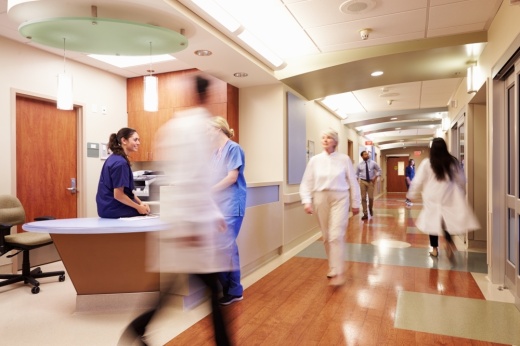Should hospitals anticipate a return of the virus in the fall and winter seasons?
We don’t even really know if the weather conditions will change the profile of the virus. In the case of the flu, there is evidence that the seasons matter more, but in the case of coronavirus, there’s not strong evidence in that regard. We should be prepared for it, obviously, to return in the fall. We should definitely have that in our minds and must be prepared for that possibility.
So you’d like to see the hospital systems kind of fully integrated into being able to test—just like they test for the flu now.
You want to get to the point where you can easily test because the early testing is key to the containment strategy. The first stage is containment so you can keep it out of our community. And then once containment starts to fail—which it often does because people talk and travel—then you go to mitigation, which is where we are right now. Which is, “Everybody stay home, try to limit the spread of the virus, and let it burn out basically.” So what you’re doing is essentially every individual becomes a firewall. By staying home and staying away from others, you let it burn out where it is and not spread. You want to have all of those ideas in place in the fall so that we’re not making it up as we go.
How well prepared is the Texas Medical Center for responding to cases of the virus?
I think what we can rely on is the very professional and highly qualified individuals that are going to have to deal with what happens. I have high confidence in the institutions of the Texas Medical Center in being able to do their very best to serve us. I think, however, that if we don’t do good mitigation, it’s just numbers. If you look in Italy, Italy has quite an advanced medical system. I know that there’s the notion that ours is far better than everybody else’s, but Italy had more beds per person than the United States does and in terms of their intensive care units, is comparable to ours. So if the Italians can be overwhelmed, then we can be overwhelmed.
So it comes back to the idea of mitigation, or “flattening the curve,” so that people get sicker at a slower rate, and then that way we keep the number of beds open and available, especially for the elderly who are suffering very badly from this disease.
What could Houston learn from the presence of COVID-19 in Seattle and other areas across the world, such as Italy?
I think that there will be information that will come out after we’re through this acute crisis. But at this point, where we are is: We are at about 8,000 cases in the United States right now [as of March 19]. And it’s going to double every few days. These things happen exponentially, and it’s very hard for us as laypeople to understand what that means. ... There’s very little you can do at this stage in terms of preparedness. You can’t stop that from happening. Even if we all stayed home right now, it’s going to have to play out over several more cycles of doubling before we’ll even know whether our stay-at-home strategy will start to produce results.
What’s the biggest piece of misinformation you have seen around the response to the coronavirus?
The other urban legend that came out is that young people don’t get the disease or don’t get it seriously, and they have nothing to worry about and can go on spring break or do whatever. And that makes them spreaders. So that’s a very harmful narrative that was born out of limited understanding of the facts. The facts are that younger people do get COVID-19. It is more likely that they’ll get milder symptoms than someone who is 65 years old, but it doesn’t help us and our strategy to have young people below the age of 20 out socializing, because they can spread the disease to other people. And young people have died from this disease in other countries, in Italy and in China, so they’re not bulletproof.
How or when will we know that it’s “safe” again? How is that measured?
One is we’re going to look at whether we’ve crossed the peak or not. If you look at the number of new cases versus the number of people that have recovered, at some point, hopefully, the number of people recovering versus the number of people being identified as infected goes down so that people are recovering faster than getting the disease. That’s how you know you’ve gone over the peak and you’re in the recovery mode. That doesn’t mean everything is safe yet, but that at least tells you that things are going in the right direction. And that might not happen for another several weeks in this country, to be quite frank with you. And it might happen in other parts of the country first than in other parts.
If you look at what’s happening in China, South Korea and Italy, you see glimpses of the future in terms of what recovery will look like. ... I think, optimistically, that might be several months before we get to the point of what I would call “normalcy.” If folks are paying attention and taking this seriously and staying home and staying safe, we’ll get there a hell of a lot sooner.
How long will it take to fully implement a vaccine?
The FDA [Food and Drug Administration] is beginning to very aggressively look for vaccine solutions, and they’ve waived a lot of these normal federal regulations that tend to slow things down quite a bit. ... It’s going to take some time. No one can tell you how long it will take to produce an effective vaccine because it has to be tested on many people to make sure it’s safe or not, how long it lasts. Some viruses are harder to get vaccines for than others, and so I’m optimistic a year from now we’ll have a vaccine of some sort. It wouldn’t shock me if we had a good prototype maybe in six months. Because then you have to scale it up and do more testing. So it takes time to deploy a safe vaccine. Because the last thing you want to do is rush a vaccine in development that doesn’t work well or could have unforeseen long-term health effects.
How do you feel about how the response to COVID-19 has been handled?
Disappointing. I think that we had time to prepare or to do a better job of preparing. We literally had months of seeing it in China, and I think there was a certain amount of—for reasons I don’t understand as a scientist—some sense that because it was in China, it wouldn’t get anywhere else, and then when it did start spreading to other places, people took the attitude of, “Well, it still won’t get here.”
The world is just too connected. We travel all over the place; people travel all over the world all the time now. Three hundred years ago, the oceans were good barriers to disease because nobody had a plane back then. Those barriers are effectively gone. I’m still confused. I’ll await explanation from various other experts as to why we squandered our time in such a way. I don’t understand it to be honest with you.
Are there other points that you would like to touch on that we have not gone over?
We have to remember and support the first responders: the hospitals, the nurses, the doctors that are really going to be going through a tough time through all this. And also the H-E-B guys and gals that are stocking the shelves and making sure that food is coming into the city. It’s a real team effort. We shouldn’t forget that this is a community-based response, not just the doctors, not just the nurses. It involves police, fire, medical services, and it involves everyone working together. It’s going to be a very stressful series of events, but we need to keep in mind that to make their lives easier, if we can just do this mitigation strategy, if we can just stay home and stay safe, it will protect not just ourselves, but protect them as well.





